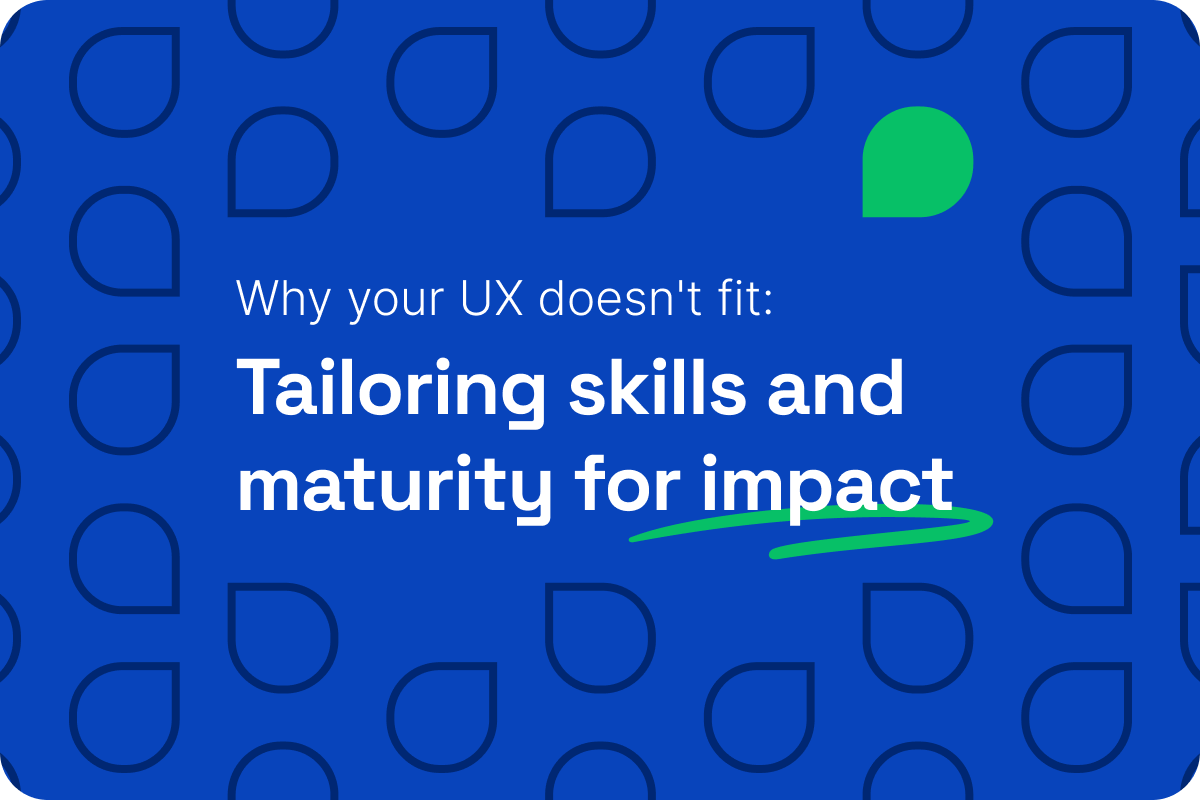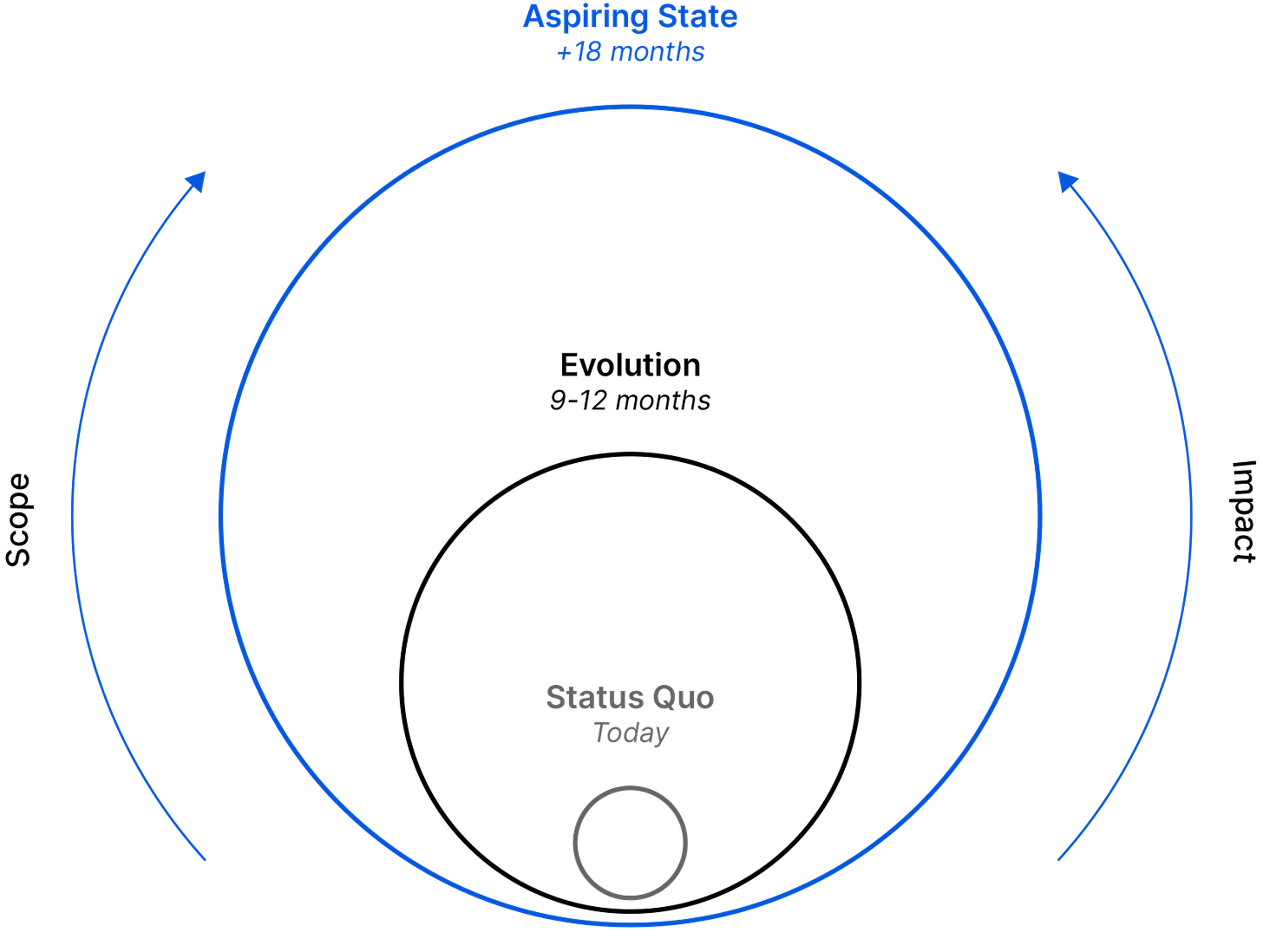Why Your UX Doesn't Fit: Tailoring Skills and Maturity For Impact
It’s finally here!
This has been in the making for quite a while. And now it’s out. Welcome to my newsletter, “Beyond the Chaos,” where I share my experiences and thoughts on leadership and systems within product and design. I hope you enjoy this first piece on UX skills and overall maturity.
Backstory
Early in my leadership career, one of my first challenges was to gain a deeper understanding of my new team's work. As I delved into their projects, several critical issues became obvious. The first thing I noticed was the inconsistent quality of work. Also, the team communicated in a 'design' language, lacking a solid grasp of business objectives and outcomes. Their approach was predominantly reactive, acting more as followers waiting for directions than proactive drivers shaping the product. And the process could have been more convenient than the one they were employing, which led to missed deadlines, further compromising our effectiveness.
In a nutshell, design wasn’t driving impact but was instead lagging behind, responding to product and tech requirements and highlighting the urgent need for a strategic pivot.
Recognizing these challenges as a new leader, it became crystal clear that the team’s skills and maturity were at the top of my priority list.
Diving into research mode, I came across a wide range of fancy, sleek, and ready-to-use UX maturity (or skill mapping) templates. Opting for one developed by industry leaders and top UX voices seemed like a savvy shortcut.
A particularly sophisticated template that promised a comprehensive framework to elevate our UX practice caught my eye. I dedicated myself to developing an extensive presentation to showcase the model's potential to our CPO.
Throughout a thirty-minute presentation, my CPO remained expressionless, nodding occasionally. He remained silent until the conclusion, when he asked me one probing question, “Umm … cool, but how can this help us make money?”
At that moment, I realized the gap between UX aspirations (including mine) and the business's priorities was even bigger. This moment of disconnect was a pivotal realization in my career that underscored the need for a different approach: upskill the team and align UX efforts directly with business value.
The Problem
This type of templates are like suits from fast fashion catalogs—designed to look as if they fit everyone. But just like those suits, when you try them on, you realize they don't quite fit as perfectly as you had hoped. These templates seem ideal on paper, yet, the smallest details make the biggest difference, like the little things that take you from looking okay to looking WOW.
UX advocates heavily promote these templates, they promise easy solutions to complex problems and make everything look simple and perfect. They come with stories of success that make them seem like they work for any issue.
However, this shiny packaging often hides the fact that what works well for one team might not work for another. The appeal of fixing everything quickly and the mistake of thinking one solution fits all can lead managers to perceive these models as perfection. They are blinded and pay no regard to the unique tweaks needed for real results in different organizations.
And that’s exactly where the problem starts. UX maturity and skill mapping templates set unrealistic expectations for everyone, leading to frustration, underperformance, and a sense of missing out.
Where to start?
A profound understanding of the business objectives and what an organization is trying to achieve is key to unlocking an impactful UX function. Your UX goals and activities should align with your business objectives, whether you’re gearing up as a startup or cruising as an established enterprise. Today we look at this from the team’s skill set and maturity.
Your team’s skills, expertise, and growth trajectory should be meticulously crafted to boost the business's strategic objectives to ensure that every aspect of the UX function contributes meaningfully to the organization’s overarching goals.
See, UX has 3 unique superpowers in any product trio:
Holistic thinking: the UX process solves problems by understanding what happens before, during, and after every moment a user interacts with a product.
User-centricity: a deep understanding of people’s world, pains, emotions, and behavior.
Visual problem-solving: an incredible tool to bring people together, drive innovation, and bring alignment to teams.
And if you think about the skills that fall under each of those, that’s just … A LOT! To leverage these 3 superpowers and drive impact, you have to be selective.
In a field as diverse as UX, where people have a wide range of skill sets, it's vital to hone the skills that most directly impact your business objectives. And that’s the starting point …
Keep it real: align UX with Business Strategy
Now let's burst the UX bubble and talk business. There are 3 questions you should ask before developing your team’s skills and overall maturity:
What are the key organizational objectives?
What levers from UX can we (the team) develop to contribute to those objectives?
What skills does the UX team need to develop to drive value?
Enough with the theory, what does that mean in reality? Let’s take a look at a couple of examples:
Hyper-Growth B2C Products
During my tenure at Vodafone Egypt, specifically with My Vodafone App and Vodafone Online Shop, our key objectives centered around enhancing the user experience to boost satisfaction, driving user engagement through personalized features, and leveraging data analytics for deeper user insights. These goals aimed at increasing both user acquisition and retention, with a sharp focus on operational efficiency and revenue growth.
Strategies such as A/B testing, user journey optimization, and conversion rate enhancement are pivotal in this high-paced and competitive environment.
Our objective was to create intuitive navigation, a delightful experience, and optimize check-out processes. A deep understanding of data, analytics, user behavior, and balancing aesthetic appeal with conversion optimization and user centricity delivered significant value to the business.
Here, the emphasis is on skills in understanding consumer behavior and enabling rapid experimentation with a focus on attracting, engaging, and retaining users.
B2B SaaS Products
A B2B SaaS environment demands different UX skills that focus on how to help users perform specific jobs efficiently, effectively, and with a sense of satisfaction. Users spend a big portion of their workday using these types of products, so helping them get through their to-dos will make their lives a bit better and result in satisfied customers, and accordingly, more business for the product.
At Staffbase, we developed a model that prioritizes skills in user research to deeply understand professional workflows, pain points, and efficiency drivers. Our focus is on clarity, functionality, and streamlining complex processes, it's less about rapid acquisition and more about deep, sustained engagement and, of course, the satisfied delight of our users when they finish a complex task.
By aligning your team’s skills and maturity model with the specific needs of the business, UX efforts are not just blindly following the motions but are genuinely driving the business forward.
The key is to understand the unique challenges and opportunities of your product and to develop UX capabilities that directly address them.
A Tailored Fit: Customizing Your UX Maturity
Put the fast-fashion magazine aside and ditch the generic approach. Identify dimensions that resonate with your business – perhaps focusing on communication, critical thinking, or process sophistication. This isn't about covering everything; it's about honing in on what will genuinely turbocharge your UX practice, and potentially deliver real impact for your product.
Where do we want to go?
Once we understand the organizational goals and the skills that our team needs to have an impact, we can take a couple of steps back. Ask yourself the question: If I had a magic wand, what would the ideal state of my UX practice look like, specifically in how it aligns with and drives business value? That’s where you, as a leader, have to put a lot of work into:
Articulate clearly that ideal state and describe it in as much detail as possible. Give it a name, and create a meaningful story around it. Stories inspire people. What would the team be like? What type of impact would they have on the product? How would that help them elevate the position of UX in the organization?
Articulate clearly each skill in that ideal state, and write down in concise sentences and clear language the type of behaviors and activities you expect from the team.
Find a balance between soft and hard skills. UX is part of the business, not a solo practice on its own. Storytelling, creative collaboration, and product thinking are good examples to reflect that.
Where are we today?
Together with your team, take an honest look at your current UX practice. Work together with your team and ask yourself the tough question: Where are we today? (How far are we from the ideal state?)
Articulate clearly your vision and direction, and start an open and honest discussion about the types of challenges the UX team is facing today in moving in that direction.
Consider having anonymous surveys before the conversation if you think that will help the team feel safe in sharing their challenges. Some people might not feel great about sharing publicly for several reasons like they could think it reflects badly on their work.
After you get the qualitative input from the team, start a dot voting exercise with the ideal state at the center. Ask everyone to put their dot where they think it fits regarding how far or close the team is from that.
Where can we go tomorrow?
So…we have a base and a target state. Now, from there, ask your team, “Where do we think we can be in ~12 months? What is hindering us from achieving that?”
The answer to this should set a clear growth and skills up-leveling plan for the whole team together. Set a realistic, achievable, and slightly flexible state. Define clear, attainable criteria for each level that reflect your organization's capacity and context.
Consider connecting this state with a certain business outcome that you want to change your team’s stake in from an early stage (follower, doer) to a more mature stage (influencer, driver).
Easy, eh?
Short answer: no.
Tailoring a UX model to fit your unique organizational needs is indeed an art. It requires patience, a willingness to iterate, and, above all, a deep understanding of the unique fabric of your business and team.
Yes, there will be moments of doubt and complexity, but the satisfaction of crafting a bespoke model that genuinely drives your organization forward, together with your team, is unparalleled. Just like a well-fitted suit, a custom-tailored UX approach not only looks better but feels right, aligning seamlessly with your team and business needs to create a real, lasting impact.
Is that it?
Short answer: also no!
There is much more to UX maturity practice than just the team’s skill sets. From strategy setting to execution and culture. But … that’s for another time, and another post in the future. Let me know though, if there is a specific aspect you would like me to touch upon.
🍉 Beyond The Chaos comes out at a very difficult time in occupied Palestine. While our lives are moving on, we shall not forget nor forgive the atrocities, horror, and starvation our Palestinian sisters and brothers have been going through every day.



